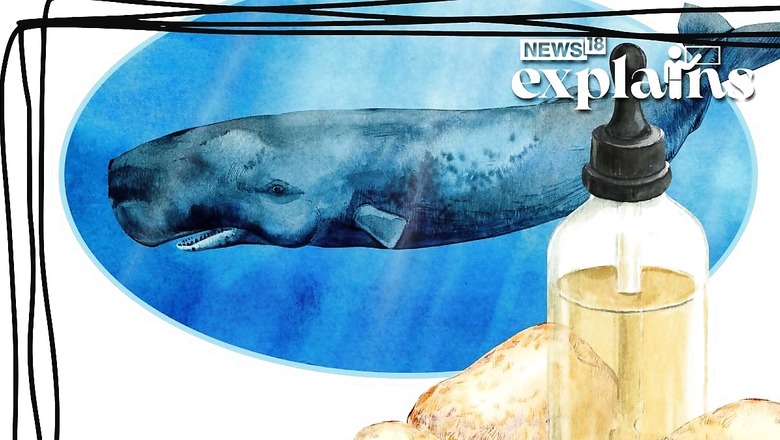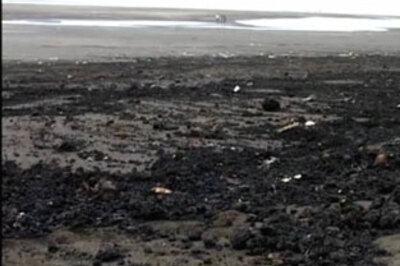
views
In a surprising turn of events, a sperm whale that washed up dead on the shores of La Palma in the Canary Islands revealed an unexpected treasure concealed within its entrails. Initially focusing on determining the cause of the whale’s demise, Antonio Fernández Rodríguez, the head of the institute of animal health and food security at the University of Las Palmas, stumbled upon a remarkable find while investigating the animal’s colon.
Amid challenging conditions characterized by heavy seas and a rising tide, conducting a thorough postmortem examination was no easy feat. Suspecting a digestive ailment, he carefully examined the colon and was surprised to discover a hard object firmly lodged within, according to a report by The Guardian. To his astonishment, he realized that it was a stone measuring approximately 50-60cm in diameter and weighing an impressive 9.5 kg.
As Rodríguez pulled the mysterious object from the whale’s colon, he realised it ambergris, also known as ‘floating gold’.
What is Ambergris, also banned in India? News18 explains:
Ambergris
Ambergris has long been recognized as one of nature’s most enigmatic phenomena. Derived from sperm whales, it has been prized and utilized for centuries, yet its true origins remained shrouded in mystery.
The captivating presence of ambergris spans back thousands of years, with fossil evidence indicating its existence dating as far back as 1.75 million years. Throughout this extensive timeline, humans have likely been engaging with this unique substance for over a millennium, according to a report by the National History Museum.
Given its allure and value, ambergris has earned monikers such as the “treasure of the sea” and “floating gold.” However, the quest to uncover its true source proved elusive for a considerable period. Various theories emerged, positing that it could be solidified sea foam or excrement from large avian species.
It was not until the advent of large-scale whaling in the 1800s that the elusive producer of ambergris, the sperm whale (Physeter macrocephalus), was definitively identified. Sperm whales have a diet that primarily consists of cephalopods like squid and cuttlefish. Typically, undigested parts such as beaks and pens are regurgitated by the whales before digestion occurs.
However, under rare circumstances, these indigestible elements find their way into the intestines of the sperm whale, where they gradually congeal and solidify over several years, forming the remarkable substance known as ambergris.
What Purpose Does it Serve in Sperm Whale’s Body?
Ambergris is believed to serve a protective function for the internal organs of sperm whales, shielding them from the sharp beaks of the squid they consume.
The exact process by which ambergris is expelled from the whale has been a subject of debate. While some assert that the whale regurgitates the mass, giving rise to the familiar term “whale vomit,” Richard Sabin, Curator of Marine Mammals at the Museum, offers an alternative perspective. He leans towards the theory that ambergris forms within the intestines and passes through the digestive tract, eventually causing an obstruction in the rectum, according to the report.
There are differing opinions on whether the whale will eventually expel the mass naturally or if the obstruction grows to a critical size, leading to a potentially fatal rupture of the whale’s rectum.
Sperm whales inhabit oceans worldwide, meaning ambergris deposits can be found floating in any ocean or washed up on various shorelines. However, it is a relatively uncommon occurrence, found in less than 5% of whale carcasses.
It is worth noting that pygmy (Kogia breviceps) and dwarf (Kogia sima) sperm whales, which also have diets rich in cephalopods, are thought to produce smaller amounts of ambergris compared to their larger counterparts.
Use in Perfumery
Ambergris, despite its initial strong faecal odor when removed from the whale, develops a more pleasant musky scent as it dries out. This unique fragrance has been noted in literature, including Herman Melville’s novel Moby Dick, where he refers to the faint stream of perfume emanating from a dead whale.
In practical perfumery, ambrein, an odorless alcohol extracted from ambergris, is highly valued for its ability to enhance the longevity of a fragrance. Perfumers have traditionally classified ambergris based on its color, with pure white varieties considered the most desirable for creating fine perfumes. Conversely, black ambergris is less valuable as it contains lower amounts of ambrein. The color of ambergris masses can change due to oxidation when exposed to the sea and air over extended periods, ranging from grey to brown.
While ambergris was historically used extensively in perfumery, the accessibility and cost of natural ambergris have led to the widespread replacement of ambrein with synthetic chemicals in most perfumes, except for the most luxurious and expensive ones.
Beyond perfumery, early Arab civilizations recognized the multifaceted properties of ambergris, known as anbar. It was employed as incense, believed to possess aphrodisiac qualities, and utilized medicinally to treat various ailments, including those affecting the brain, heart, and senses, the report says.
Why is It Banned in India?
While possession and trade of ambergris is banned in countries like the USA, Australia, and India, it remains a tradable commodity with certain limitations in several other countries. In India, sperm whales are protected under Schedule 2 of the Wildlife Protection Act, and as a result, the possession or trade of any by-products derived from them, including ambergris, is illegal under the provisions of the Wildlife Protection Act of 1972.
Smuggling of ambergris has been observed, where criminal networks procure it from coastal areas in India and transport it to destination countries via intermediaries that may have less stringent sea trade regulations with India. These smuggling operations take advantage of the differences in enforcement and regulations across various countries.



















Comments
0 comment